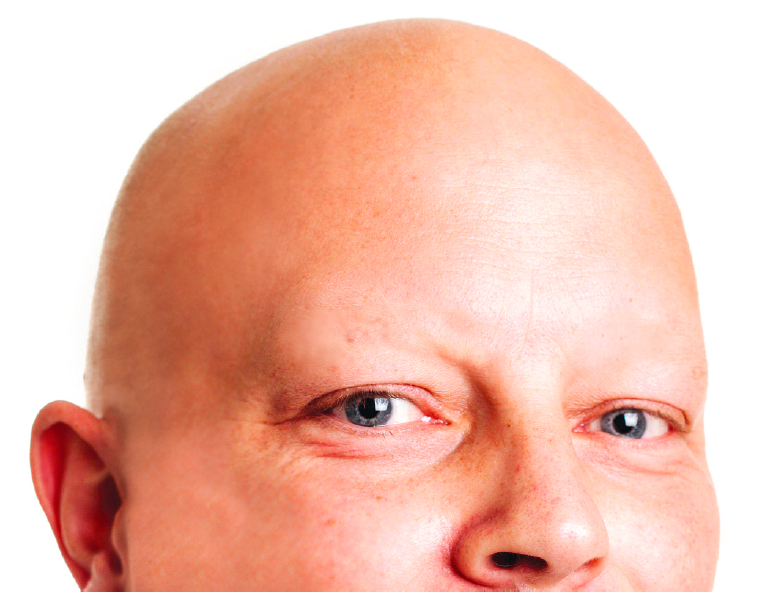
© SOHL /ISTOCKPHOTO
This content was published in 2013. We do not recommend that you take any clinical decisions based on this information without first ensuring you have checked the latest guidance.
A. Alopecia is a general term for hair loss and there are different types. Alopecia areata, for example, is associated with small, coin-shaped patches of baldness on the scalp, alopecia totalis describes complete loss of hair on the scalp and alopecia universalis describes the loss of all body hair. Alopecia androgenetica describes a receding hairline and thinning of hair on the crown. Although this is often termed “male pattern baldness”, it can also affect post-menopausal women.
Other types of hair loss include traction alopecia, anagen effluvium and telogen effluvium.
Alopecia areata affects one or two people per 1,000 and is more common in the 15–29 year age group. The cause is unknown but it is thought to be an auto-immune condition. It is often associated with stress or emotional upheaval. Trichotillomania (the habitual pulling out of hair) and dermatophyte scalp infection can also cause patchy hair loss. In alopecia areata, spontaneous hair regrowth usually occurs after a few months. The course, however, is unpredictable and symptoms can recur. Regrowing hair is sometimes white at first. Alopecia totalis and alopecia universalis have also been linked to autoimmunity. Alopecia universalis rarely resolves spontaneously.
The most common type of hair loss is probably alopecia androgenetica. This inherited condition depends on dihydrotestosterone (DHT), a metabolite of testosterone. It is believed that DHT “strangles” hair follicles by reducing the blood supply so that the follicles become miniaturised and the individual hairs become thinner, less pigmented and eventually fall out. Alopecia androgenetica can lead to complete baldness but hair loss is usually confined to the scalp — eyebrows are unaffected.
Traction alopecia is caused by continual tension on the hair due to hairstyle (eg, a tight ponytail or cornrows) or hair extensions. Hair loss can be permanent if the traction is prolonged.
Anagen effluvium occurs when normal growth is abruptly halted. This is a well known effect of cytotoxic drugs (eg, cyclophosphamide) and, more rarely, it is seen with heparin, warfarin, carbimazole and colchicine. The anagen phase is the active phase of hair growth. In anagen effluvium hair loss can be rapid and some individuals lose all their hair. The hair usually begins to regrow if the drug is discontinued.
During the telogen phase of hair growth, follicles are resting and hair is normally lost at a rate of about 50–100 hairs per day (often seen when brushing or washing the hair). Hairs will be at different stages of the growth cycle and telogen effluvium occurs when larger than normal amounts of hair are in the telogen phase, resulting in them falling out at the same time and therefore widespread hairthinning. The condition has various triggers, including trauma, high fever, childbirth, surgery and some drugs.
Diagnosis
Diagnosis of alopecia androgenetica will often be made by the patient and confirmed by the GP. Both alopecia androgenetica and alopecia areata are normally diagnosed on the basis of a history and examination. In alopecia areata short, broken hairs (“exclamation mark hairs”) are often seen around the edges of the round bald patches. A careful history enables the GP to rule out trichotillomania, anagen effluvium and telogen effluvium as possibilities. Investigations are only required if it is necessary to distinguish between alopecia areata and fungal infections of the scalp.
Up to 50 per cent of patients will recover from alopecia areata within a year, although many people experience more than one episode. Between 14 and 25 per cent of patients will progress to develop alopecia totalis or universalis.
This patient asking about Regaine for his eyebrows is likely to have alopecia universalis.
Treatment
Male pattern baldness can be treated with 5-alpha reductase inhibitors, such as finasteride and dutasteride, or with minoxidil. (The enzyme 5-alpha reductase is responsible for converting testosterone to DHT.) Finasteride is licensed for this indication and dutasteride is prescribed off-label. Neither are licensed for or effective in treating alopecia areata, totalis or universalis.
In male pattern baldness, topically applied minoxidil increases the duration of the anagen phase and normalises the size of follicles but the mechanism by which this occurs is not understood. It can only restore existing hair growth and cannot reactivate dead follicles. About 4 per cent of patients will see some regrowth within 12 months but this is rarely dense. Early treatment gives the best results, when the bald patch is no more than 10cm in diameter and still has some residual hair in the area.
Patients should be warned that the product takes about 12 weeks to start working and that hair growth is only stimulated for as long as minoxidil is used. If the treatment is discontinued, the baldness will soon recur.
Minoxidil can be purchased over the counter as a topical lotion, in concentrations of 2 per cent for men and women and 5 per cent for men only. A 5 per cent foam formulation is also available. One millilitre of solution (or half a capful of foam) is applied twice a day to the dry scalp. The drug is also an antihypertensive and, although less than 2 per cent of the applied dose is absorbed, patients with cardiovascular disease should be referred to their GP before treatment.
Hair loss can be difficult to cope with, affecting image and self-confidence. Loss of eyebrows — a feature of alopecia universalis — can be particularly distressing. Some practitioners claim that minoxidil can be effective for restoring hair to eyebrows, making them thicker. However the drug is not licensed for use in this way and it would need to be applied with great care to avoid any running into the eyes. The lotion contains alcohol, which can cause burning, and irritation of the eyes.
Potent topical corticosteroids are widely used for alopecia although there is little evidence for their effectiveness. Intralesional injections and oral corticosteroids can be effective in patchy alopecia but the results are less impressive in patients with alopecia totalis or universalis. Skin atrophy at the injection site can be a problem and there is a risk of cataract formation and raised intraocular pressure if intralesional corticosteroids are used near the eyes.
Contact immunotherapy using squaric acid dibutylester (SADBE) or 2,3-diphenyl cyclopropenone (DPCP) is also used to treat alopecia. This involves sensitising the patient to the chosen compound and then applying increasing concentrations, at weekly intervals, until a dermatitis reaction is elicited. Response rates to this treatment are highly variable and those with alopecia totalis or alopecia universalis tend to respond poorly. Both SADBE and DPCP are unlicensed medicines.
Light therapy has been used for alopecia but results are often poor.
Signposting
The most effective option for this patient is likely to be micropigmentation (cosmetic tattooing) to create eyebrows. This would provide a permanent solution.
He could be referred to his GP but many treatments for alopecia are private and you may choose to signpost to a trichologist (but see Panel).
You could also signpost him to the patient support group, Alopecia UK (www.alopecia online.org.uk).
Panel: Before you refer to a trichologist
Trichology is the science of the structure, function and diseases of the human hair and people who practise in this area call themselves trichologists.
There is no formal register of trichologists in the UK and anyone can claim to be one. So-called “qualified” trichologists are members of either The Trichological Society or the Institute of Trichologists. In order to become members of these organisations a course of training must be undertaken and examinations successfully completed. Trichology is not a regulated profession although some trichologists may also have nursing or medical qualifications. Practitioners who perform hair transplants require a medical qualification and registration with the General Medical Council.
The Trichological Society (www.hairscientists.org/index.htm) may be approached for further information, support and help with finding reputable practitioners.
Key points
- There are different types of alopecia. The most common is probably alopecia androgenetica, which affects men and postmenopausal women.
- Depending on the type of alopecia (and cause), hair loss — which is not exclusive to the scalp — can be permanent or it can resolve spontaneously.
- Management of alopecia includes pharmaceutical agents, such as 5-alpha reductase inhibitors and steroids (note that many products are licensed for specific types of alopecia) and cosmetic options such as tattooing.
Reference
- Macdonald Hull SP, Wood ML, Hutchinson PE et al. Guidelines for the management of alopecia areata. British Journal of Dermatology 2003;149:692–69.
You might also be interested in…
How to select the right mouthwash

Thalassaemia and iron supplements
